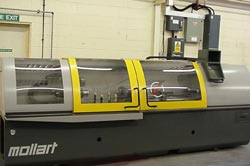
Posted to News on 31st Jul 2013, 11:44
How to design machine guards to deter defeating of interlocks
Jeremy Procter, a Member of BSI's MCE/3 committee, former Convenor of the European Standards Committee responsible for Machine Guards (CEN TC114 WG11), and Managing Director of Procter Machine Guarding, explains how the careful design of machine guards can successfully discourage the dangerous practice of defeating interlocks during setting, operation and maintenance.

The Health and Safety Executive has recently published a report entitled Identifying the human factors associated with the defeating of interlocks on Computer Numerical Control (CNC) machines (reference RR974), which was prepared on the HSE's behalf by the Health and Safety Laboratory (HSL), an agency of the HSE. The research was undertaken on a qualitative basis using a relatively small sample of SMEs (small and medium-sized enterprises), so the report cautions against extrapolating from the results; nonetheless, the findings are such that important lessons can be learnt by designers of all types of machines with interlocked guards, not just CNC machine tools.
First, it is striking how common it is for CNC machines to have the guard interlocks defeated during setting and operation, with supervisors and managers often 'turning a blind eye' to the practice. Among the operatives, supervisors and managers interviewed for the research, it was generally felt that defeating the guard interlocks was the norm, rather than an uncommon practice.
Why operatives defeat machine guard interlocks
The reasons given for defeating interlocks varied, but typically operators complained that process visibility was poor or inadequate with guards in place, particularly during set-up and when proving new CNC programs. A related issue was that clear panels quickly became marked by swarf, which restricted visibility. Another reason was that large or awkwardly-shaped workpieces made the use of physical guards impractical, particularly for one-offs or short production runs when 'as fitted' machine guards would clash with the workpiece. In some cases it was claimed that operatives could be more productive by clearing swarf without having to stop machines, or by deburring one area of a workpiece while others were still being machined.
Operatives were generally aware of the hazards associated with machine tools but often believed that their experience meant they could 'safely' operate machines without guards because they were aware of the hazards and could take appropriate precautions - such as remaining at a safe distance and running the machine at low speeds. Some of the experienced operatives also commented that warning signs were of little use because the messages they conveyed were 'common sense'; these signs were thought to be effective for apprentices only.
Techniques employed to defeat guard interlocks included the removal of guards, removal of switches and the use of dummy actuators in electromechanical switches. It appears that older machines and 'semi-CNC' machines (typically those with limited CNC functionality or manual machines that had been modified by the addition of CNC equipment) tend to have interlocks that are easier to defeat. During the course of their research, the HSL team spoke to individuals who expressed the view that guards and interlocks were installed not so much for safeguarding operatives but for protecting machine designers who wished to claim compliance with safety standards and Regulations.
Guard design
It would be easy for machine builders to blame operatives and say that guards are there to provide protection and that interlocks should not be overridden, but there is a strong argument in favour of designing guards that provide protection without hindering production - and which, therefore, eliminate the need for the interlocks to be defeated. The main standard for machine guards is BS EN 953:1997+A1:2009, Safety of Machinery. Guards. General requirements for the design and construction of fixed and movable guards. This covers all types of machinery, from simple drive couplings to very complex installations involving robots, conveyors and processing machinery. The standard lists those aspects of machinery, people and guards that need to be considered, and this includes ergonomics. For instance, in section 5, Principal requirements for the design and construction of guards, the following points are made explicitly:
5.2.4 Viewing: To minimise the need to remove them, guards shall be designed and constructed to offer adequate viewing of the process.
5.2.5 Ergonomic aspects: Guards shall be designed and constructed taking into account ergonomic principles (see also EN ISO 12100-2:2003, 4.8.2 and 4.8.3). [NB EN ISO 12100-2:2003 has since been superseded by EN ISO 12100:2010 but the corresponding clauses can still be found in sub-section 4.8, Observing ergonomic principles.]
In addition, BS EN 953 makes it clear that foreseeable use and reasonably foreseeable misuse should be taken into account, and that provision should be made for replacement of degradable parts.
BS EN 953 is a Type B standard, meaning that Type C standards can supplement or modify its provisions. Type C standards are published for a variety of different machines including, for example, milling machines (BS EN 13128:2001+A2:2009) and turning machines (BS EN ISO 23125:2010). These two standards make specific references to both guarding and interlocking, so designers need to be familiar with all relevant standards when designing the guarding, interlocking and safety-related control system.
Practical measures
In terms of the practical measures that can be taken when designing machine guards, one of the most important is to discuss with operatives how the machine will be used. A better understanding of all operations - from setting to running, observing, cleaning and measuring - can help the designer to accommodate the operative's requirements in a way that, as far as practicable, eliminates the need to run the machine with guards open (note that the safety-related control system can be designed to allow the machine to run with restricted performance when the guards are open). In addition, viewing panels can be incorporated in positions that will provide adequate process visibility; if appropriate, such panels should be constructed from abrasion-resistant materials and/or be easily replaceable. The choice of guard interlock should be guided by a machine risk assessment but, if it is likely that interlocks will be defeated using dummy actuators, the guard designer could specify uniquely-coded RFID switches or similar devices that are more difficult to defeat; of course, such switches and actuators must be attached to the guards and machine frame in such a way that they cannot be removed easily using readily available tools.
Other measures to be considered include better machine lighting to improve visibility, and installing cameras that enable close-up images of the process to be viewed safely on a monitor outside the danger zone. If cameras are installed, however, they need to be protected so that they do not themselves have their view restricted by swarf or cutting fluid, or their lens or protective screen damaged.
Guard design and manufacture - in-house or out-source?
Whether machine builders are manufacturing one-offs or series machines, taking full responsibility for the guarding in-house often turns out to be more expensive and takes longer than out-sourcing it to a specialist. Furthermore, machine builders are not always as familiar with the guarding standards as designers employed by specialist guarding companies, which runs the risk of the guards being non-compliant or over-engineered.
Procter Machine Guarding claims to be the UK's leading machinery guarding specialist, offering a comprehensive service to survey, design, manufacture and install machine guards nationwide. All guards are designed to comply with EC and HSE requirements and are CE marked or issued with a Declaration of Conformity as appropriate on completion. When necessary, Procter works closely with other suppliers to ensure that interlocking, light curtains and safety-related control systems function correctly in conjunction with the physical guarding. All of this can help machine builders to ensure that guards are cost-effective, ergonomic and standards-compliant so that the complete machine can be CE marked to the Machinery Directive.
Follow the link to find out more about custom-designed machine guards and the services available from Procter Machine Guarding.
Want the latest machine building news straight to your inbox? Become a MachineBuilding member for free today >>















